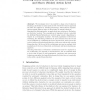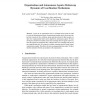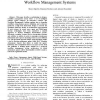27 search results - page 2 / 6 » How (not) to model autonomous behaviour |
IWINAC
2007
Springer
14 years 1 months ago
2007
Springer
We investigate how it is possible to shape robot behaviour adopting a molecular or molar point of view. These two ways to approach the issue are inspired by Learning Psychology, wh...
RAS
2007
13 years 6 months ago
2007
Developmental robotics is concerned with the design of algorithms that promote robot adaptation and learning through qualitative growth of behaviour and increasing levels of compe...
AUSAI
1997
Springer
13 years 11 months ago
1997
Springer
Co-ordination is the glue that binds the activities of autonomous problem-solving agents together into a functional whole. Co-ordination mechanisms for distributed problem-solving ...
ATAL
2008
Springer
13 years 8 months ago
2008
Springer
Agents in an organization need to coordinate their actions in order to reach the organizational goals. Organizational models specify the desired behaviour in terms of roles, relati...
WOA
2003
13 years 8 months ago
2003
— This paper describes a methodology to design a workflow management system where a set of intelligent software agents composes an interactive scenario. The Workflow Management C...



